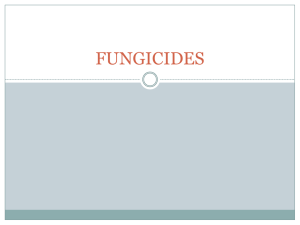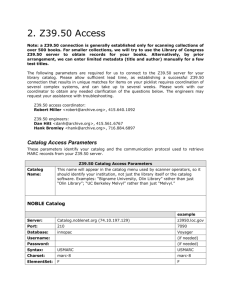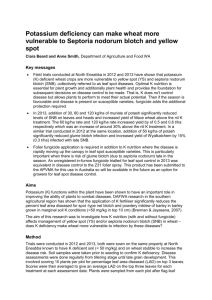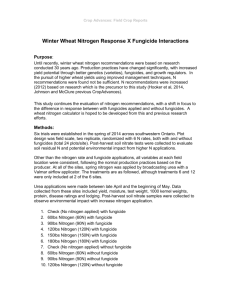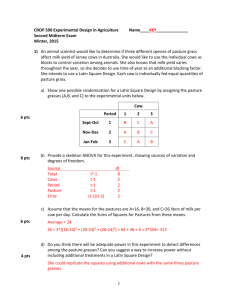Foliar fungicide applications at or prior to first node stage (Z31) can
advertisement
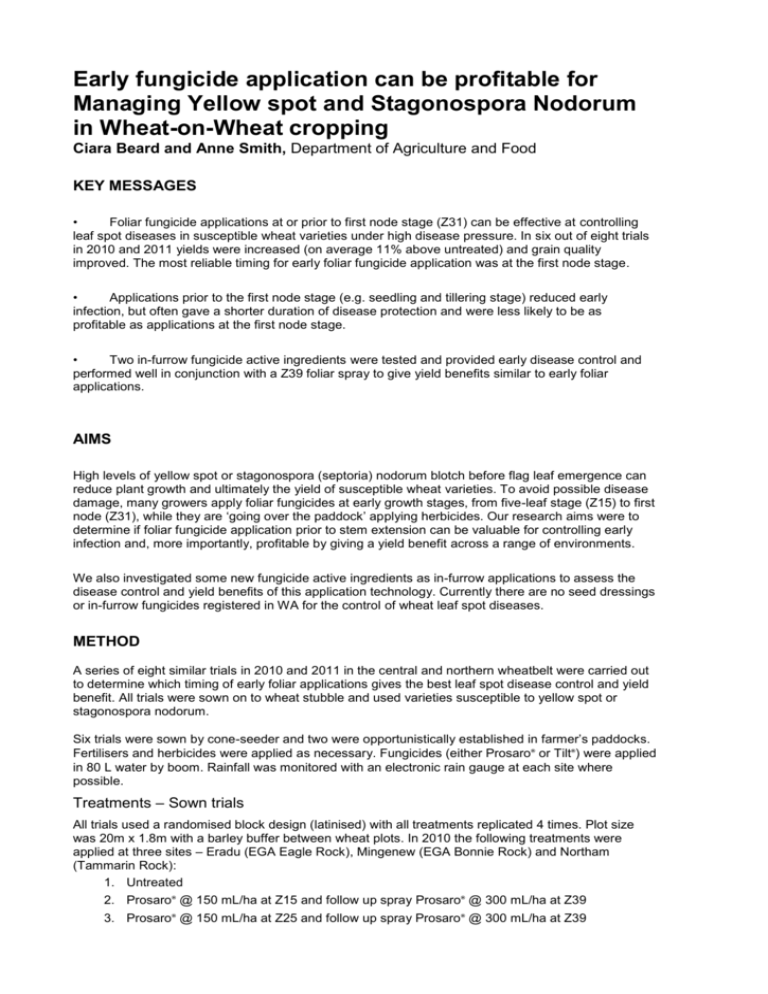
Early fungicide application can be profitable for Managing Yellow spot and Stagonospora Nodorum in Wheat-on-Wheat cropping Ciara Beard and Anne Smith, Department of Agriculture and Food KEY MESSAGES • Foliar fungicide applications at or prior to first node stage (Z31) can be effective at controlling leaf spot diseases in susceptible wheat varieties under high disease pressure. In six out of eight trials in 2010 and 2011 yields were increased (on average 11% above untreated) and grain quality improved. The most reliable timing for early foliar fungicide application was at the first node stage. • Applications prior to the first node stage (e.g. seedling and tillering stage) reduced early infection, but often gave a shorter duration of disease protection and were less likely to be as profitable as applications at the first node stage. • Two in-furrow fungicide active ingredients were tested and provided early disease control and performed well in conjunction with a Z39 foliar spray to give yield benefits similar to early foliar applications. AIMS High levels of yellow spot or stagonospora (septoria) nodorum blotch before flag leaf emergence can reduce plant growth and ultimately the yield of susceptible wheat varieties. To avoid possible disease damage, many growers apply foliar fungicides at early growth stages, from five-leaf stage (Z15) to first node (Z31), while they are ‘going over the paddock’ applying herbicides. Our research aims were to determine if foliar fungicide application prior to stem extension can be valuable for controlling early infection and, more importantly, profitable by giving a yield benefit across a range of environments. We also investigated some new fungicide active ingredients as in-furrow applications to assess the disease control and yield benefits of this application technology. Currently there are no seed dressings or in-furrow fungicides registered in WA for the control of wheat leaf spot diseases. METHOD A series of eight similar trials in 2010 and 2011 in the central and northern wheatbelt were carried out to determine which timing of early foliar applications gives the best leaf spot disease control and yield benefit. All trials were sown on to wheat stubble and used varieties susceptible to yellow spot or stagonospora nodorum. Six trials were sown by cone-seeder and two were opportunistically established in farmer’s paddocks. Fertilisers and herbicides were applied as necessary. Fungicides (either Prosaro® or Tilt®) were applied in 80 L water by boom. Rainfall was monitored with an electronic rain gauge at each site where possible. Treatments – Sown trials All trials used a randomised block design (latinised) with all treatments replicated 4 times. Plot size was 20m x 1.8m with a barley buffer between wheat plots. In 2010 the following treatments were applied at three sites – Eradu (EGA Eagle Rock), Mingenew (EGA Bonnie Rock) and Northam (Tammarin Rock): 1. Untreated 2. Prosaro® @ 150 mL/ha at Z15 and follow up spray Prosaro® @ 300 mL/ha at Z39 3. Prosaro® @ 150 mL/ha at Z25 and follow up spray Prosaro® @ 300 mL/ha at Z39 4. Prosaro® @ 150 mL/ha at Z31 and follow up spray Prosaro® @ 300 mL/ha at Z39 5. Prosaro® @ 300 mL/ha at Z15 6. Prosaro® @ 300 mL/ha at Z31 7. Prosaro® @ 300 mL/ha at Z39 8. Full control – Four fungicide sprays to assess site yield potential In 2011 these treatments were also applied at three additional sites - Eradu (EGA Eagle Rock), Mingenew (Mace) and Cunderdin (Yitpi) however, in these trials, the second (Z39) spray on treatments 2, 3 and 4 was 150 mL/ha Prosaro®. At the Eradu and Mingenew sites there were also four additional treatments - two infurrow products with or without follow up foliar fungicide applications at Z39. The two in-furrow fungicide active ingredients tested are not named as they are not currently registered for this use in WA. Treatments – Opportunistic trials In 2011, trials were established within growers’ paddocks at two locations in the northern wheatbelt, Nangetty and Yuna. The trials had a randomised block design (each plot was 20 m x 5m) with four replicates of the following treatments at each site: 1. Unsprayed, 2. Sprayed at Z30 (when grower sprayed), 3. Sprayed at Z30 + follow up spray at Z39/41, 4. Sprayed at Z39/41, 5. Full control (fungicide at high rate applied at Z30, Z39 and Z55). Measurements Plant emergence counts were conducted on all sown plots 3-5 weeks after sowing. Necrotic leaf area was determined on top 3 to 4 leaves (on 15 tillers /plot) from all plots at Z15, Z25, Z31, Z39, Z55 (i.e. before each foliar fungicide spray) and Z72, or in the case of opportunistic trials assessed at regular intervals after trial establishment. Pathogen identification as either yellow spot or stagonospora nodorum was confirmed through AGWEST Plant Labs at two times during the season. Trials were harvested and a grain sample from each plot weighed and sub-sampled for grain quality (protein, hectolitre weight, grain sievings and thousand-grain weight). RESULTS AND DISCUSSION Early fungicide sprays This research has found that when conditions favour early season disease (for example, susceptible wheat variety sown on wheat stubble following good opening rains), spraying for yellow spot and stagonospora (septoria) nodorum prior to stem extension can be economical (example trial result shown in Figure 1). Yield (t/ha) 70 Flag-1 area diseased 60 2.50 $135 Yield (t/ha) 2.00 $96 $128 $93 $117 $115 50 40 1.50 30 1.00 20 0.50 10 0.00 Leaf area diseased (Flag-1) 3.00 0 Untreated Prosaro Prosaro Prosaro Prosaro Prosaro Prosaro Full control 150mL@Z15 150mL@Z25 150mL@Z31 300mL@Z15 300mL@Z31 300mL@Z39 300mL@Z39 300mL@Z39 300mL@Z39 Figure 1. Early fungicide applications reduced disease and increased yield on EGA Eagle Rock grown on wheat stubble at Eradu in 2010. For each trial in which a single application at seedling / tillering stage (Z15-25) gave a significant yield benefit, a similar or greater benefit was achieved with a single application at stem extension (Z31). The yield penalty for delaying application until Z31 was found to be minimal across all trials so, on the whole, the Z31 timing was found to be the best for added length of crop protection. In four out of the eight trials conducted, fungicide application at Z31 with a follow up spray at Z39 was the most profitable treatment (or equal best in one case). In two of the eight trials a single fungicide application at Z31 was the most profitable treatment (Table 1). On average across all eight trials the Z31 +Z39 double spray strategy was the most profitable giving on average a profit of $109 above untreated. Table 1. Summary of treatment results from eight trials* conducted over during 2010-2011 Fungicide Treatment Average yield increase above untreated (t/ha) Average profit # above untreated 0.2 0.3 0.3 0.3 0.5 57 75 57 56 109 Single spray Z15 or Z25 Single spray Z31 Single spray Z41 Double spray Z15/Z25 and Z39 Double spray Z31 and Z39 * Results from Northam 2010 trial not included as grain yields were poor due to drought and did not respond to fungicide application # Profit depended on fungicide product and rate used. Wheat price used in 2011= $270/t, in 2010 = $313/t. Cost of fungicide application = $8/ha, Fungicide : Prosaro® at 300 mL/ha = $19.80, Tilt® at 500 mL/ha = $9. Fungicide responses are a result of the disease being present and a favourable environment to allow disease progression throughout the season. In some years there was insufficient disease at Z39 or insufficient rain after this growth stage, to make a flag leaf application profitable (Table 2). For example, in 2010, early application of foliar fungicide was profitable at both Eradu and Mingenew where yellow spot and stagonospora nodorum developed to moderate levels. While a flag leaf spray (at Z39) was profitable at Eradu (where 97 mm of rain fell in the eight weeks after Z39), it was not profitable at Mingenew which had a dry spring (only 64 mm of rain fell at the site after Z39). In some situations, such as Northam in 2010, no fungicide applications increased profit due to drought conditions which did not allow foliar diseases to develop or the crop to yield adequately. Conversely, at Cunderdin in 2011, disease levels were low or moderate prior to stem extension with no profit from application at these times, however favourable conditions, particularly after flag leaf emergence resulted in positive responses to later spray application timings. Table 2. Summary of eight trials conducted during 2010-2011. Location and Year Variety Disease without fungicide control (Average leaf area diseased on top 3 leaves) Z25/30 Z65/69 Disease Fungicide timings increasing yield Rain during 8 weeks after Z39 Notes on season Above average rainfall growing season, lots of regular falls July and August One heavy downpour end of may (54mm), Sept only two large falls (18mm each) Lots of regular small falls (and a few large) throughout season favoured ongoing disease One heavy downpour end of may (54mm), Sept only two large falls (18mm each) Low levels of disease and very little disease response to fungicide through year but with very good rain during grain fill Below average rainfall. Dry June, July and September Eradu, 2011 Eagle Rock 13 50 YS & SNB All 98 Mingenew, 2011 Mace 5 45 YS & SNB All 130 Yuna*, 2011 Mace 6 38 YS dominant Z41 79 Nangetty*, 2011 Calingiri 7 40 YS & SNB Z31+41, Z41 130 (estimate) Cunderdin, 2011 Yitpi 11 43 YS dominant All except Z14 96 Eradu, 2010 Mingenew, 2010 Eagle Rock Bonnie Rock 19 36 All 97 10 29 Z32, Z25+Z41, Z32+41 64 Dry June and September Northam, 2010 Tammarin Rock 2 21 n/a 25 Reasonable July rainfall, but drought during Aug-Oct, No yield responses were evident YS & SNB SNB dominant YS dominant * Opportunistic trials in which the earliest fungicide application was Z30 In-furrow fungicide treatments The in-furrow fungicides tested, performed similarly to a single foliar fungicide at Z15 or Z31 and when used in conjunction with a Z39 foliar fungicide spray gave similar yield results to the 2 spray treatments. At Eradu in 2011, where yellow spot dominated, both of the in-furrow fungicides significantly reduced disease until the last disease assessment at Z69 which resulted in significant yield increases above the untreated (Figure 2). The same was true at Mingenew in 2011, where stagonospora nodorum was dominant for much of the season. 5 Yield (t/ha) 4 3 2 1 0 Untreated Prosaro @ Z15 Prosaro @ Z31 Product A in-furrow Product B in-furrow Product A in-furrow & Prosaro @ Z39 Product B in-furrow & Prosaro @ Z39 Full Control - 4 fungicide sprays Figure 2. Yield, of fungicide treatments applied to EGA Eagle Rock at Eradu in 2011. CONCLUSION When a wheat variety susceptible to yellow spot and/or stagonospora (septoria) nodorum blotch is grown on wheat stubble, onset of these diseases prior to stem extension is likely to occur in most seasons. These trials have shown that fungicide applications applied at or before stem extension (Z31) can be effective and provide positive economic returns when disease pressures are moderate to high. Disease development and fungicide response is determined by the presence of the disease in the crop and the occurrence of disease favourable conditions following application. Therefore in the presence of early season disease pressure and continuing favourable conditions, applications prior to stem extension are more likely to be effective. Similarly, flag leaf applications are more likely to be effective when weather conditions favour development of disease after application and during grain filling. Application of foliar fungicides at seedling or tillering growth stages will not provide economic benefit if disease is not present or not developing at the time of application. Fungicide application before Z31 can be justified when disease is intense at these stages, however this research has shown that in most cases it can be more profitable to delay application until Z31. A follow up spray at Z39 is likely to be profitable and provide additional yield response if disease development continues towards the flag leaf and at least 80 mm of rainfall is expected in the eight weeks after Z39. The in-furrow fungicides tested show promise for leaf spot disease control and in the future they may become an alternative to foliar applications, for the control of early season leaf spot infections. KEY WORDS Yellow spot, Fungicide, Wheat, Disease ACKNOWLEDGMENTS GRDC for funding the research, DAFWA Geraldton Research Support Unit for seeding and harvesting trials. Mingenew Irwin Group and the grain growers, Clancy Michael, Randal Levett, Greg Creasy, Ashley Eastough, Andrew Messina, for hosting trials. GRDC Project No.: DAW00210 Paper reviewed by: Geoff Thomas and Bill MacLeod


